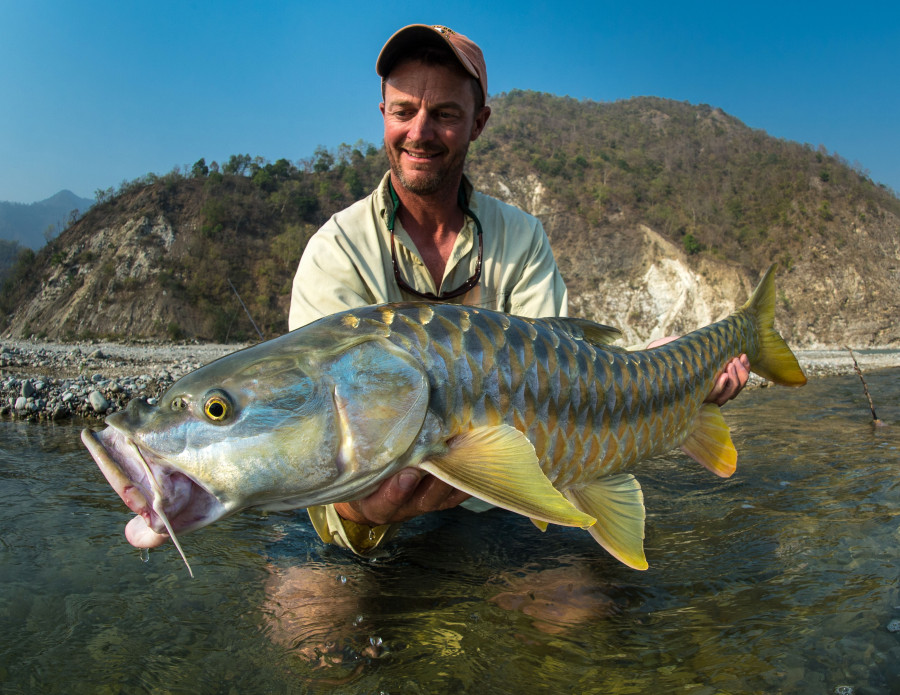National
Experts raise concern over declining Mahseer numbers
Conservationists have expressed serious concern about degrading aquatic ecosystem that is directly affecting the population of Golden Mahseer, an iconic fish found in the Himalayan rivers.
Conservationists have expressed serious concern about degrading aquatic ecosystem that is directly affecting the population of Golden Mahseer, an iconic fish found in the Himalayan rivers.
Commonly known as “Sahar” or “Satta” in western Nepal, Golden Mahseer is critically threatened owing to the degradation of habitats everywhere including in Nepal.
According to Dr Tek Bahadur Gurung, livestock and fisheries director at the Nepal Agricultural Research Council (NARC), rapid decline in Golden Mahseer population in the country was mostly due to human activities that destroyed their natural habitat.
“Environmental degradation, habitat loss, increasing use of water resources for irrigation, hydropower demand and invasive species are among the major reason behind loss of mahseer,” he said.
Studies have shown that the Golden Mahseer population has declined by more than 50 per cent in rivers. The International Union for Conservation of Nature Red List of Threatened Species has put the fish species in the endangered category . Of late, overfishing and destructive forms of fishing are also endangering Golden Mahseers.
“Fishing techniques like use of dynamite, poisoning water resources, modified nets and electro-fishing are not only killing these fish, but also damaging the whole aquatic system,” Gurung said.
Two species of Golden Mahseer — Tot putitora and Tor tor — are found in Nepal, and they have been enlisted as endangered and threatened species respectively.
Speaking at an interaction jointly organised by National Trust for Nature Conservation (NTNC) and the Mahseer Trust, experts said poor implementation of existing law has failed to keep check on activities that threaten aquatic life.
The Aquatic Animal Protection Act (1960) prohibits use of any kind of electric current, explosive substance or poisonous substance with the intention of catching and killing any aquatic animal in any water. Still, such fishing practices are still common in the country.
Conservationists have proposed promoting Golden Mahseer species as one of country’s “Big 3 Aquatic Fauna” along with the Gangetic Dolphin and the Gharial.
Gopal Prasad Bhattarai, deputy director general of Department of National Park and Wildlife Conservation, said the department could not do much to protect Golden Mahseer species, which are found in rivers that are not part of protected areas.
“The National Park and Wildlife Conservation Act that regulates the department is concerned about conserving wildlife inside national parks, but mahseers are found in rivers outside,” he said. “Our aquatic ecosystem is not protected properly. Major bodies do not have even experts in fisheries.”
Arun S Rana from Himalayan Anglers said a dedicated institution for aquatic biodiversity was necessary for conservation of valuable aquatic life like Golden Mahseer.
He also suggested expansion of protected areas’ boundaries to cover key rivers and spawning grounds of Golden Mahseers, banning sand and gravel mining
within 3 km of river confluences and involving traditional fishers in recreational fishing business to diversify their income options as well as to protect endangered fish population from overfishing.
“Promoting recreational fishing or sport fishing can help in conserving mahseers. In recreational fishing anglers release the fish after catching them. It is fishing for pleasure or competition and different from commercial fishing,” Rana said.
Ian Pett, chairman of Mahseer Trust, said Nepal could identify core Golden Mahseer habitats, give them national park’s status and work with riverine communities and other stakeholders to engage them in conservation efforts.
“There is a need of effective collaborations among anglers, farmers, , policy makers, ecologists and other stakeholders to raise awareness and come up with appropriate conservation action,” he said.




 21.74°C Kathmandu
21.74°C Kathmandu














